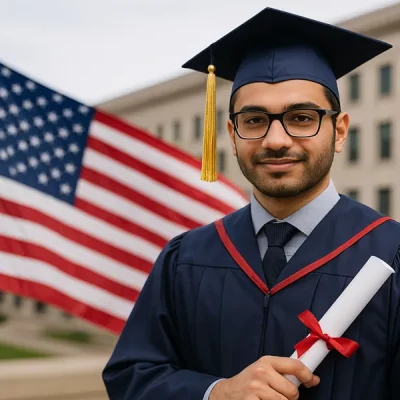Unsecured Loans for Overseas Education: An Introduction
Table of Contents
Millions of students go for education at universities abroad, and there are plenty of choices available to them to finance their studies. One of the ways to pursue higher education is through the organization where one is working, and these organizations fund their studies. But the number is way too less, and most of the students rely on educational loans. With the advent of fintech companies and the expanding space of educational loans, there is no dearth of institutions helping students get loans.
Classification of Loans
Essentially education loans are of two categories. One is the secured loans backed by collateral with utmost liquidity. It’s always easy to get a loan from a liquid asset, e.g., Land and Property. In contrast, there are other liquid assets like FD, Shares, Gold, etc. These liquid assets certainly help streamline the loan process since they are backed by assets that are more sustainable and rank low in the risk index. But not everyone has assets with such liquidity, and students used to struggle in getting unsecured loans, i.e., ones not backed by liquid assets or, to put it simply, those who don’t have collateral to support their loan.
The Changing Landscape
A few years back, there was limited space for those wanting to get unsecured loans. The advent of fintech companies and policy change for the loan disbursal via a more pragmatic risk assessment mechanism has changed the entire landscape. Several institutions are working in the Fin-tech ecosystem, helping students getting loans without much trouble. There is a standardized mechanism for risk assessment of the loan dispersal process, which calculates the risk in a more pragmatic way and aims to make the whole process way more fluidic than it used to be a decade earlier.
Now Fin-tech companies have come up with a comprehensive structure that factors in a plethora of criteria to assess the loan repaying ability of a loanee. The Fin-tech space has helped banks make a holistic assessment of the loan profile by factoring in things like the current employability, the prospects after getting the degree, and post-degree payback ability by a holistic market-based analysis of the future jobs. Fin-tech companies have developed standardized software to correctly assess the risk associated with the loans, which has helped the unsecured loan space.
Current Status of Unsecured loans to Study Abroad
Unsecured loans were an uphill task for students and lenders, but RBI made certain amends to the lending process around a decade back, which has helped millions of students get unsecured loans. Now RBI has granted liberty to banks for lending unsecured loans in the education space.
RBIs policy change has helped Fin-Tech in expanding the scope and scale for those who don’t have the assets to back up their loan. There are certain rules mentioned below that a loan applicant should know about getting loans without collateral:
- For loans unto INR 4lakhs, one doesn’t need to give collateral while taking a loan from a government bank.
- With certain caveats, RBI allows lending by all the banks when it comes to loans amounting to INR 7.5lakhs.
- For loans exceeding the amount of INR 7.5lakhs, private banks and NBFC provide a wide range of options. But certain criteria have to meet viz. The future opportunities, the institution for which loan is to be granted, etc.
Some prominent lenders and their terms and conditions with respect to unsecured loans:
- Axis bank is a major name in the banking sector with a wide range of loan options, including secured and unsecured loans. Secured loans of INR 70 lakhs and Unsecured loans worth INR 40 lakhs are offered to students wanting to stay abroad. The interest rates usually vary from 11.25% to 13%. The interest rates depend on an individual’s profile. Fin-Tech companies help students in getting the maximum loan amount with minimal interest rates.
- Avanse is another big name in the list of lenders providing loans for studies abroad. The loan amount varies from INR 1 lakh to INR 40 lakhs, varying from one student to another. The interest rates have dual components. One is the base rate, and the other is the spread. The base rate remains by and large at 12.65%, while the spread is dynamic—the overall interest rates swings between 12.65% to 16%.
- HDFC Credila is another prominent name among NBFCs providing loans without collateral. The upper limit of the loan amount is INR 40 lakhs. The base lending rate is currently at 12.05%, and the spread is dynamic.
- InCred is an NBFC that provides collateral-backed loans amounting to INR 1 crore, while those without any collateral are pegged around INR 40 lakhs. The unsecured loan may increase based on the applicant’s profile, and the interest rate has a range of 11.75% to 16%.
For abroad education loans, GyanDhan is the right place to go. They provide all the facilities at your doorstep. Right from collecting your document to negotiating the best terms for your loan is taken care of by them. Once they are at the helm of affairs, right from the issuance of a visa to getting you an international credit card is arranged by them without you having to go through the trouble of waiting in queues and submitting documents. They have a well-established system with departments specialized in different areas of the whole process. They have approved loans totalling a whopping INR 1000 crore for more than 3500 students in a mere span of 4 years.
Guest Blog by GyanDhan






![Fully Funded Scholarships in Canada for Nigerian Students [2025 Guide] Scholarships in Canada for Nigerians](https://www.universityliving.com/blog/wp-content/uploads/2025/04/Fully-Funded-Scholarships-in-Canada-for-Nigerian-Students-400x400.webp)
